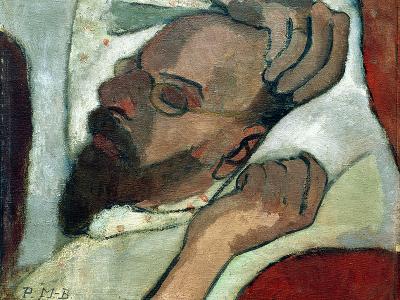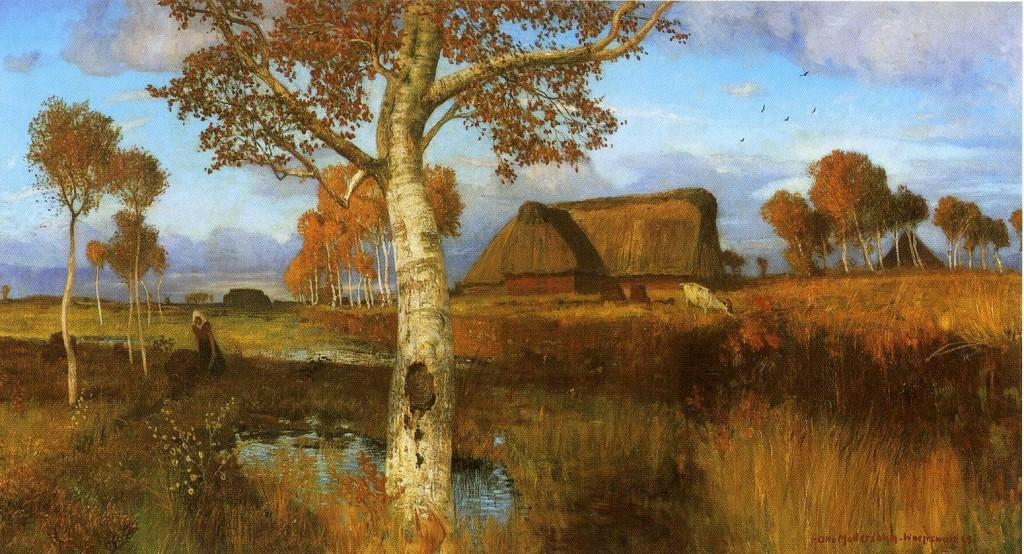Otto Modersohn on:
[Wikipedia]
[Google]
[Amazon]
 Friedrich Wilhelm Otto Modersohn (22 February 1865, Soest – 10 March 1943,
Friedrich Wilhelm Otto Modersohn (22 February 1865, Soest – 10 March 1943,
 In 1884, he began his studies at the Art Academy of Düsseldorf. Four years later, he moved to the
In 1884, he began his studies at the Art Academy of Düsseldorf. Four years later, he moved to the
 From 1874 to 1889, he concentrated on small-scale studies and landscapes, painted directly from nature in the
From 1874 to 1889, he concentrated on small-scale studies and landscapes, painted directly from nature in the
"Neues Otto-Modersohn-Museum in Tecklenburg"
''Westfälische Nachrichten'', 22 October 2015 .
Otto Modersohn Museum
Fischerhude
Otto Modersohn Museum
Tecklenburg
Rainer Maria Rilke on Otto Modersohn
{{DEFAULTSORT:Modersohn, Otto 19th-century German painters 19th-century male artists German male painters 20th-century German painters 20th-century male artists 1865 births 1943 deaths Paula Modersohn-Becker
 Friedrich Wilhelm Otto Modersohn (22 February 1865, Soest – 10 March 1943,
Friedrich Wilhelm Otto Modersohn (22 February 1865, Soest – 10 March 1943, Rotenburg Rotenburg may refer to:
*Rotenburg (district), Lower Saxony, Germany
*Rotenburg an der Wümme, capital of the district
*Rotenburg an der Fulda, near Kassel in Hesse
*Rothenburg ob der Tauber, in the Franconia region of Bavaria
*Hersfeld-Rotenburg, ...
) was a German landscape
A landscape is the visible features of an area of land, its landforms, and how they integrate with natural or man-made features, often considered in terms of their aesthetic appeal.''New Oxford American Dictionary''. A landscape includes the ...
painter. He was a co-founder of the Art Colony at Worpswede
Worpswede (Northern Low Saxon: ''Worpsweed'') is a municipality in the Osterholz-Scharmbeck, district of Osterholz, in Lower Saxony, Germany. It is situated in the Teufelsmoor, northeast of Bremen (city), Bremen. The small town itself is located n ...
.
Life
 In 1884, he began his studies at the Art Academy of Düsseldorf. Four years later, he moved to the
In 1884, he began his studies at the Art Academy of Düsseldorf. Four years later, he moved to the Academy of Fine Arts, Karlsruhe
The State Academy of Fine Arts Karlsruhe () is an art school located in Karlsruhe, Baden-Württemberg, Germany.
History
The Academy was founded in 1854 by Frederick I, Grand Duke of Baden, with the landscape painter Johann Wilhelm Schirmer as ...
, where he studied under Hermann Baisch. In July 1889, he made his first visit to Worpswede with Fritz Mackensen
Fritz Mackensen (born 8 April 1866 in Greene, near Kreiensen, Duchy of Brunswick – 12 May 1953 in Bremen) was a German painter of the Düsseldorf school of painting and Art Nouveau. He was a friend of Otto Modersohn and Hans am Ende, and w ...
. In August, Hans am Ende
Hans am Ende (31 December 1864, Trier – 9 July 1918, Stettin) was a German Impressionism, Impressionist painter.
In 1889 he co-founded the artists' colony in Worpswede with Fritz Overbeck, Otto Modersohn, and Heinrich Vogeler. In 1895 this g ...
followed. They were later joined by Fritz Overbeck
August Friedrich Overbeck, known as Fritz (15 September 1869 in Bremen – 8 June 1909 in Vegesack) was a German painter and engraver.
Biography
He was the son of the Technical Director at Norddeutscher Lloyd. After graduating from the lo ...
(1893) and Heinrich Vogeler
Heinrich Vogeler (December 12, 1872 – June 14, 1942) was a German painter, designer, and architect, associated with the Düsseldorf school of painting.
Early life
He was born in Bremen, and studied at the Kunstakademie Düsseldorf from 1 ...
(1894); all students from Düsseldorf. In 1895, they presented their first group exhibition at the Kunsthalle Bremen
The Kunsthalle Bremen is an art museum in Bremen, Germany. It is located close to the Bremen Old Town on the "Culture Mile" (german: Kulturmeile). The Kunsthalle was built in 1849, enlarged in 1902 by architect Eduard Gildemeister, and expanded ...
. They were largely panned by the critics, but went on to a major breakthrough at the Munich Glaspalast.
In 1897, the Art Colony was officially established and Modersohn married Helene Schröder (1868-1900), the daughter of a Bremen merchant. Two years later, he resigned from the association, citing his continuing fight for the personal, individual liberty of every artist. Vogeler and Overbeck joined him in leaving. The couple had one daughter, Elsbeth (1898-1984). The next year, his wife died after a long illness. In 1901, he remarried. His new wife, Paula Becker, was also a well-known painter. She died in 1907, of an embolism
An embolism is the lodging of an embolus, a blockage-causing piece of material, inside a blood vessel. The embolus may be a blood clot (thrombus), a fat globule ( fat embolism), a bubble of air or other gas (gas embolism), amniotic fluid (amniot ...
, shortly after giving birth to their daughter Mathilde "Tille" (1907-1998).Helmut Stelljes: ''Mathilde, die Tochter einer berühmten Worpsweder Malerin. Was geschah nach dem frühen Tod der Malerin Paula Modersohn-Becker mit der Tochter Tille Modersohn?'' In: Heimat-Rundblick. Geschichte, Kultur, Natur. Nr. 71, 4/2004 (''Winter 2004''). Druckerpresse-Verlag, , S. 4–5. At that point, Modersohn felt that he could not remain in Worpswede and moved to Fischerhude, a nearby village. His third wife was , daughter of the painter Heinrich Breling
Heinrich Christoph Gottlieb Breling (14 October 1849, Burgdorf - 6 September 1914, Fischerhude, near Ottersberg) was a German painter of historical and genre scenes. He was the first artist in what would later become known as the "Artists' Colo ...
. She was primarily a singer, but painted as well. They had two sons, Ulrich (1913-1943) and , who also became a painter.
In 1911, when the Kunsthalle Bremen purchased Van Gogh
Vincent Willem van Gogh (; 30 March 185329 July 1890) was a Dutch Post-Impressionist painter who posthumously became one of the most famous and influential figures in Western art history. In a decade, he created about 2,100 artworks, inclu ...
's ''Field with Poppies'', Modersohn was the only Worpswede artist to support the museum, concluding that nationalistic sentiments should play no role in the world of art. In the 1920s and early 30s, he and Louise made extensive study trips throughout Germany and, in 1933, he acquired an old farmhouse on the Gailenberg in Bad Hindelang
Bad Hindelang is a municipality in the district of Oberallgäu in Bavaria in Germany. As of 2008 it has a population of 4,915. Its sulphur spring was used for cures in the 19th century and today the municipality is a major health resort.
Geograp ...
for use as a studio. Three years later, he became blind in his right eye, due to a detached retina
Retinal detachment is a disorder of the eye in which the retina peels away from its underlying layer of support tissue. Initial detachment may be localized, but without rapid treatment the entire retina may detach, leading to vision loss and blin ...
. This forced him to remain in his studio rather than paint outdoors. He was awarded the Goethe Medal for Art & Science in 1940. A year before his death, he was persuaded to speak on the subject of visual arts at the Ministry of Public Enlightenment and Propaganda
The Reich Ministry for Public Enlightenment and Propaganda (; RMVP), also known simply as the Ministry of Propaganda (), controlled the content of the press, literature, visual arts, film, theater, music and radio in Nazi Germany.
The ministry ...
.
Work
 From 1874 to 1889, he concentrated on small-scale studies and landscapes, painted directly from nature in the
From 1874 to 1889, he concentrated on small-scale studies and landscapes, painted directly from nature in the Plein Air
''En plein air'' (; French for 'outdoors'), or ''plein air'' painting, is the act of painting outdoors.
This method contrasts with studio painting or academic rules that might create a predetermined look. The theory of 'En plein air' painting ...
style of the Barbizon School
The Barbizon school of painters were part of an art movement towards Realism in art, which arose in the context of the dominant Romantic Movement of the time. The Barbizon school was active roughly from 1830 through 1870. It takes its name f ...
. After 1889, his search for a truly natural style led gradually to more colorful canvases. Around 1900, he and several other Worpswede artists began doing illustrations and designs for Stollwerck
Stollwerck GmbH is a German chocolate manufacturer. It was founded in 1839 and expanded internationally in Europe and America, becoming the second largest producer of chocolate in the United States by 1900. Since 2011 it has belonged to Belg ...
, the German chocolate company.
Artistic interaction with his second wife, Paula, led to the development of a style emphasizing simplicity and humanity, expressed in their maxim "Das Ding an sich in Stimmung" (roughly, "The thing-in-itself
In Kantian philosophy, the thing-in-itself (german: Ding an sich) is the status of objects as they are, independent of representation and observation. The concept of the thing-in-itself was introduced by the German philosopher Immanuel Kant, and ...
in the mood/feeling"). Although his wife's subject matter was vastly different, he considered her work a complement to his.
After World War II, a Modersohn Museum was established in Gailenberg and later relocated to Fischerhude. Another Otto Modersohn Museum showcasing his early work in Westphalia opened in Tecklenburg
Tecklenburg () is a town in the district of Steinfurt, in North Rhine-Westphalia, Germany. Its name comes from the ruined castle around which it was built. The town is situated on the Hermannsweg hiking trail.
The coat of arms shows an anchor a ...
in 2015.Johannes Loy"Neues Otto-Modersohn-Museum in Tecklenburg"
''Westfälische Nachrichten'', 22 October 2015 .
References
Further reading
* Kai Artinger: ''Otto Modersohns Langbehnsches Kunstideal'', in: Strohmeyer/Artinger/Krogmann: ''Landschaft, Licht und niederdeutscher Mythos. Die Worpsweder Kunst und der Nationalsozialismus'', VDG, Weimar 2000, , Pages 117-130 * * Marina Bohlmann-Modersohn: ''Otto Modersohn – Leben und Werk'', Otto Modersohn Museum, Fischerhude 2005, * Christian Modersohn: ''Das Erbe meines Vaters – Zwei Leben für die Kunst.'' Otto Modersohn Museum, Fischerhude 2005.Documentary film
* ''So broad and big - The nature of Otto Modersohn'', Directed by Carlo Modersohn, narrated byHanns Zischler
Hanns Zischler (born 18 June 1947) is a German actor known for his portrayal of Hans in Steven Spielberg's film ''Munich''. According to the Internet Movie Database, Zischler has appeared in 171 movies since 1968.
He is known in Sweden for his r ...
, produced by Carlo Modersohn, in cooperation with the Otto Modersohn Museum, 78 min., 2011. ()
External links
*Otto Modersohn Museum
Fischerhude
Otto Modersohn Museum
Tecklenburg
Rainer Maria Rilke on Otto Modersohn
{{DEFAULTSORT:Modersohn, Otto 19th-century German painters 19th-century male artists German male painters 20th-century German painters 20th-century male artists 1865 births 1943 deaths Paula Modersohn-Becker